Air Conditioner Basics
Most people tend to believe that air conditioners lower the temperature in their homes merely by pumping cool air in. To dispel this myth what is really happening is a cycle were warm air is being removed from your house & pushed back in as cooler air. The cycle will then continue until your thermostat reaches the desired temperature it has been set for.
An air conditioner is basically a refrigeration unit without the insullated box which contains a temperature in a given space. An air conditioner controls a whole enviroment. To provide cooling the evaporation of a refrigerant like Freon is used. The term Freon is generically desribed as 'various nonflammable fluorocarbons used as refrigerants & as propellants for aerosols.'
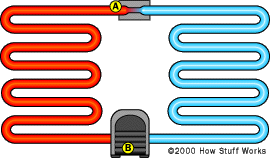
Diagram of a commonly used air conditioner.
This is how the evaporation cycle in an air conditioner works (See How Refrigerators Work for complete details on this cycle):
Air Conditioner Facts
- What happens in the diagram above is the compressor compresses cool Freon gas, causing it to become hot, high-pressure Freon gas (the red part in the diagram).
- This hot gas runs through a set of coils so it can evaporate its heat, & it then condenses into a liquid.
- Freon liquid will then run through an expansion valve, & in the process it dissipates to become cold, low-pressure Freon gas (the light blue part in the diagram).
- Cold gas runs through a set of coils that allow the gas to absorb heat & cool down the air inside the building or specified enviroment..
- The compressor needs some oil for lubrication & this is why Freon has a small amount of lightweight oil mixed into it.
Air conditioner are useful in keeping the air in your home clean. Indoor units are fitted with filters which are used to catch dust, mold spores, pollen & other allergens together with everyday dirt & smoke found in air. Most air conditioners also function as dehumidifiers. There are 2 ways in which the excess water can be used to improve efficiency of the units. Firstly the excess water is used in helping the unit remain cool before getting rid of the water through an external hose leading to the outside. Secondly other units will reuse the condensed moisture (cooled water) by routing it back into the system.
By now you should have a general concept & idea of how air conditioning works. In the next section, window & split-system units will be explained in some more detail.
Window & Split-system AC Units
A window air conditioner unit brings about complete air conditioning in a small space. The units are designed small enough to fit into any standard window frame. You close the window down on the unit, plug it in & turn it on to get cool air. Inside the cover of an unplugged window unit, you'll find these components:
- A control unit
- Two fans
- A compressor
- An expansion valve
- A hot coil (on the outside)
- A chilled coil (on the inside)
Air is blown over the coils to improve their ability to evaporate heat (to the outside air) & cold (to the room being cooled).
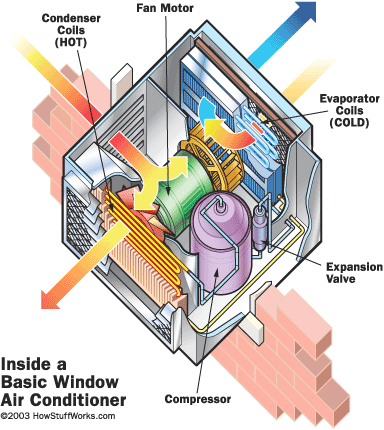
Larger scale air-conditioning applications used for a larger area like entire buildings & factory spaces, it becomes time to start looking at split-system units. A split-system air conditioner splits the cold side from the hot side of the system, like in the diagram below:
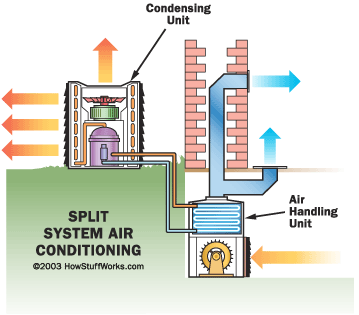
The hot side part of the equipment known as the condensing unit, is situated somewhere outside the building. The cold side of the unit consists of an expansion valve & the cold coil. This is generally placed onto a furnace or some other air handler. This mechanism known as the air handler blows ai through the coil & circulates the air throughout the building using a series of ducts.
The unit consists of a long, spiral coil in the shape of a cylinder. Inside the coil is a fan which blows air through the coil, along with a weather-resistant compressor & some control logic. This form of cooling has evolved over the years because it's low cost & another benfit being that the noise inside the house is considerably reduced, while the noise outside tends to increase. The only difference between a split system & a window air conditioner is that the split air conditioner has the cold and hot sides placed apart from each other & that capacity is higher by making the ciols & compressor larger.
In larger business offices, big department stores, warehouses, shopping centres & other sizeable buildings, the condensing unit is usually found on the roof & can be rather massive. Another option would be many smaller units placed on the roof, each attached inside to a small air handler that cools a specific area in the building.
When talking particularly about multi-story buildings, the split-system begins to run into slight problems. Distance limitations with the pipe between the condensor & the air handler exceed lengths and cause lubrication difficulties in the compressor. The series of ducts needed to route the air becomes to long and unmanageable. This is a good time to consider the chilled-water system.
Chilled-water & Cooling-tower AC Units
With a chilled-water system the entire air conditioner would be placed on the roof or behind the building. It cools water to between 4.4 and 7.2 degrees Celsius (40 and 45 degrees Fahrenheit). The chilled water then gets piped throughout the building & gets connected to air handlers as needed. If the chilled-water pipe is well insulated there is no practical limit to the lengths it can reach.
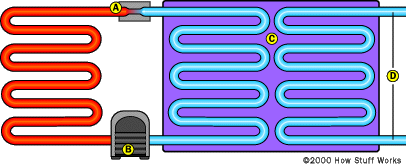
The diagram to the left shows a completely standard air conditioner. The heat exchanger allows the cold Freon to chill the water that runs throughout the building.
In all of the systems mentioned earlier, air is always used to evaporate the heat from the outside coil. In large systems, the efficiency can be improved significantly by using a cooling tower. The cooling tower creates a stream of lower-temperature water. This water runs through a heat exchanger & cools the hot coils of the air conditioner unit. Initially this system would cost more to buy, but the energy savings can be significant over time, especially in areas with low humidity areas. So fairly quickly the system would of paid for itself.
- Cooling towers all work on the same principles & come in various shapes & sizes.
- Some of the water gets evaporates when the cooling tower blows air through a stream of water.
- In most cases the water trickles through a thick sheet of open plastic mesh.
- Air gets blown through the mesh at right angles to the water flow.
- The evaporation then cools the stream of the water.
- Some water will always be lost due to evaporation, the cooling tower will constantly add water to the system to make up for the difference lost during this process.
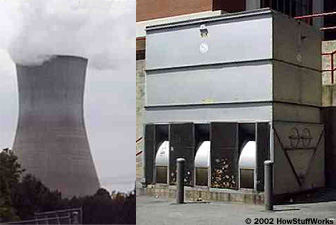
Air Conditioner Cooling Towers
Depending on the relative humidity of the air & the barometric pressure will result in the amount of cooling one gets from a cooling tower.
For eg: assuming a 35-degree Celsius (95-degree Fahrenheit) day, barometric pressure of 29.92 inches being the normal sea-level pressure & 80% humidity, the temperature of the water in the cooling tower drop about 3.36 degrees to 31.7 degrees Celsius (6 degrees to 89 degrees Fahrenheit). If the humidity is 50%, then the water teperature will drop perhaps 8.4 degrees to 26.7 degrees Celsius (15 degrees to 80 degrees Fahrenheit). If the humidity is 20%, then the water temperature will drop about 15.7 degrees to 19.4 degrees Celsius (28 degrees to 67 degrees Fahrenheit). Even small temperature drops can have a significant effect on energy consumption.
If you walking behind a building & find a unit that has large quantities of water running through a thick sheet of plastic mesh, you will know you have found a cooling tower!
In many office complexes & college campuses, cooling towers & air conditioning equipment are centralized, & chilled water is routed to all of the buildings through kilometers of underground pipes.
In the next section, we'll look at how much all this cooling power costs.
BTU & EER
The standard method used for rating the capacity of most air conditioners is in British thermal units (BTU). BTU would be the amount of heat which is required to raise the temperature of 1 pound (0.45 kg) of water 0.56 degrees Celsius (1 degree Fahrenheit). Mathematically, 1 BTU equals 1,055 joules. In heating & cooling terms, 1 "ton" equals 12,000 BTU.
Regular window air conditioners would be rated at around 10,000 BTU. To give you a comparison a regular 2,0000 square-foot (185.8 m2) home might have a 5-ton (60,000 BTU) air conditioning system, this would imply that you might need around 30 BTU per sqaure foot. (Remember that these are only rough estimates. Contact a HVAC contractor to size the air conditoner of your specific needs)
(EER) Stands for energy efficiency rating of an air conditoner which is the BTU rating over its wattage. As an example, if a 10,000-BTU air conditioner consumes 1,200 watts, its EER is 8.3 (10,000 BTU/1,200 watts). Preferably one would like the EER to be at its highest, however a higher EER is usually accompanied by a higher price.
Take a look at Climate Magic for a great explanation of how seasonal energy efficiency is rated (SEER). |